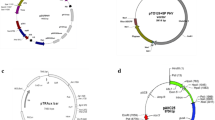Abstract
It was found that the supplement of 10−4 mol/L AgNO3, in N6 medium enhanced the induction of type I embryogenic calli from immature embryos of maize inbred P9-10. After high-osmotic treatment, the induced calli was taken as transformation recipient to be bombarded with plasmid pMG6 carrying synthetic Bt gene by PDS-1000/He genegun. A total of 14 resistant calli were obtained after screening subsequently on the mediums with gradually increasing selective pressure. 10 plants were regenerated from the resistant calli on 3 different induction media, and 8 out of the 10 regenerated plants were confirmed to be integrated with Bt gene by PCR and Southern blotting analysis. Results of ELSA showed that the Bt-protein content in the leaves of the transgenic plants varied between 20–200 ng/g fresh weight.
Similar content being viewed by others
References
Gordon-Kamm, W. J., Spencer, T. M., Managano, M. I.,et al., Transformation of maize cells and regeneration of fertile transgenic plants,Plant Cell, 1990, 2: 603.
Walters, D. A., Vetsch, C. S., Potts, D. E.et al., Transformation and inheritance of a hygromycin phosphotransferase gene in maize plants,Plant Molecular Biology, 1992, 18: 189.
Vain, P., McMullen, M. D., Finer, J. J., Osmotic treatment enhances particle bombardment-mediated transient and stable transformation of maize,Plant Cell Reports, 1993, 12: 84.
Armstrong, C. L., Parker, G. B., Pershing, J. C.et al., Field evalualion of European corn borer control in progeny of 173 transgenic corn events expressing an insecticidal protrin fromRacillus thuirinqiensis, Crop Science, 1995, 35: 550.
Ishida, Y., Saito, H., Ohta, S.et al., High efficiency transformation of maize (Zeu mays L.) mediated byAgrobacterium tumefaciens, Nature Biotechnology, 1996, 14: 745.
Wang, G. Y., Du, T. U., Zhang, H.et al., Transfer of Bt-toxin protein gene into mahe by high-velocity micrioprojectile bornbardments and regeneration of transgenic plants,Science in China, Ser. B, 1995, 38(7): 817.
Wan, Y. C., Widholm, J. M., Lamaux, P. G., Type I callus as a bombardment target for generating fertile transgenic maize (Zea mays L.),Planta, 1995, 196: 7.
Zhang, H., Wang, G. Y., Xie, Y. J.et al., Transformations of maize embryogenic calli mediated by ultrasonication and regeneration of fertile transgenic plants, Sciencein China, Ser. C, 1997, 40(3): 316.
Clark, M. F., Lister, R. M., Bar-Joseph, M., EI.ISA techniques,Methods in Enzymol, 1982, 118: 742.
Songstad, D. D., Armstrong, C. L., Petersen, W. L., AgNO3, increases type II callus production from immature embryos of maize inbred 873 and its derivatives,Plant Cell Reports, 1991, 9: 699.
Wunn, J., Kloti, A., Burkhardt, P. K.et al., Transgenic:Indica rice breeding line IR58 expressing a syntheticcryIA(b) gene fromBacillus thuringiensis provides effective insect pest control,Bio. Technology, 1996, 14: 171.
Author information
Authors and Affiliations
About this article
Cite this article
Zhou, F., Wang, G., Xie, Y. et al. Establishment of a genetic transformation system for maize inbred P9-10. Chin. Sci. Bull. 44, 624–627 (1999). https://doi.org/10.1007/BF03182723
Received:
Issue Date:
DOI: https://doi.org/10.1007/BF03182723




